We had an exciting day here on our mountainside a few days ago. After being with us for more than two weeks, the children have finally decided it’s time they ventured out on their own. No, I’m not writing about our own children; they made that big move many years ago. Now it’s the eastern phoebe young who have rapidly outgrown their nest, covered their fragile little bodies with feathers, exercised and strengthened their wings, and made that first (surely somewhat scary) leap into the air, thankfully coming down to a safe landing on the porch rail about ten feet away. What excitement that must have been for those little ones.
Adult phoebes first built a nest on the crossbeam close under the roof of our small entry porch five years ago. Their chosen spot is only about five feet from a good viewing place just inside our glass storm door. We happily spent many minutes each day watching their progress as they built their nest. For anyone who doesn’t already know, nest building is a time-consuming, complicated, and messy process made more difficult by the fact that the only tools involved are beaks and tiny feet. The nest was anchored to the beam with bits of mud, hard to come by during stretches of several days without rain. The bulk of the nest was an incredible mixture of small twigs, bits of dried grass, soft mosses and lichens, and other materials that caught the eye of the female nest builder. It’s not a straightforward process either. Decisions have to be made about where each piece goes. We’ve watched as the phoebe brought tiny strands of grass, studied the partially-built nest, apparently decided those particular materials were not suitable for the next spot in the project, tossed them aside, and flew off to find something better. The rejected debris scattered over the corner of the porch were clear evidence of the search for just the perfect materials. Some days we could tell the nest walls were a bit higher; the next day part of the wall had been removed as a new plan was developed.
Eventually the nest was completed to everyone’s satisfaction and the female settled in for her extended sitting spell. We’ve read that the incubation period for phoebe eggs is about sixteen days, but it seemed additional time might be needed for getting comfortable with the nest and actually producing the eggs. We all had a long wait ahead of us. Although we tried not to disturb the birds any more than absolutely necessary, we found it hard to resist taking a peek whenever we passed near our viewing spot during the day. Mama phoebe would greet our approach with any icy stare.
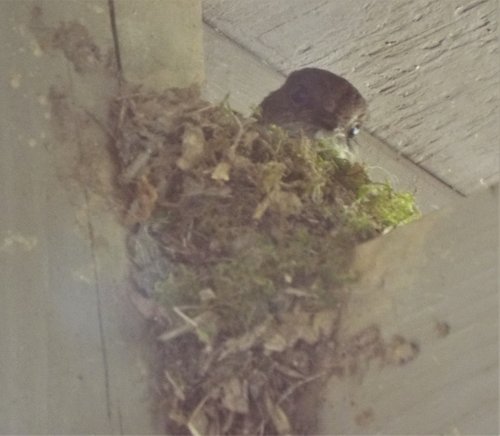
Mama phoebe’s icy stare
Whenever we had to exit the house by way of the entry porch door, the phoebe would fly ten or fifteen feet to one of several nearby azaleas or a witch hazel tree, where she watched closely until we had moved the appropriate safe distance away from the nest area. During the entire incubation period the male phoebe could usually be seen sitting on one of several perches from which he guarded the area, leaving only occasionally to get food for his mate or himself. When the female left the nest to take a break, he continued duty at his watch post. Watch and wait, watch and wait.
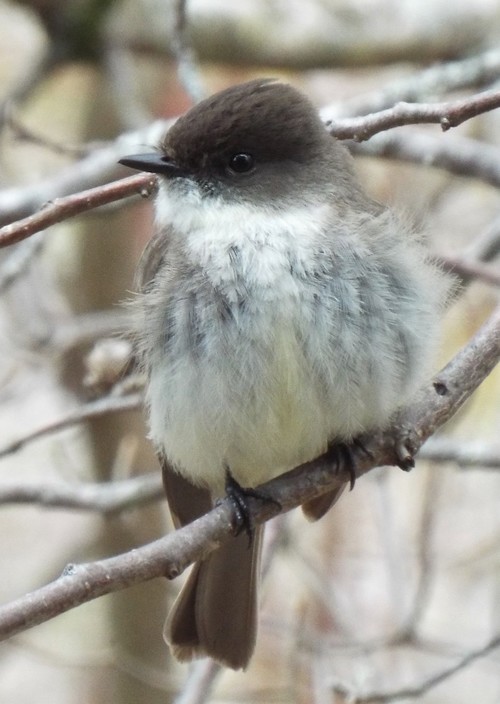
Adult eastern phoebe, always on alert
Each year the basic process has been the same for the birds and for us. This year was slightly different because a lot more nest building was needed. The original nest deteriorated a bit during the seasons it was unoccupied so each year has required repairs or remodeling. After some storms this past year the old nest was pretty much gone, so the new builders had to start from scratch after removing the debris remaining from the old nest. This beam on our porch must be a good site for a nest since this is now the fifth year it has been used. It’s well sheltered from the weather and fairly inaccessible to any intruders who might attempt to disturb the nest. We have no way to know if the same pair has returned each year to their original nesting spot or if the current phoebes are the great-great grandchildren of the original pair coming back to the old homeplace. It’s exciting to see the phoebes when they arrive after being absent for most of the year and it’s fascinating to observe the adults repeat the now-familiar patterns.
We had to be away this year for a few days at the time when we expected the hatching might occur. We were concerned when we came home and did not immediately see the female phoebe sitting on the nest. Surely the young ones had not already hatched and moved away. But we soon saw the adults busy at their new activities, constantly going back and forth finding food and bringing it back to the hungry babies. Such a demanding time for both of the adults. At first we knew the young ones were in the nest because we could see the adults carrying food, looking down into the nest, and then poking something downward before flying off again on the next mission. Eventually we saw little beaks lifting above the edge of the nest and, a few days later, two small heads rising into view. Phoebes commonly have up to four young at a time, but we were only aware of seeing two this time.
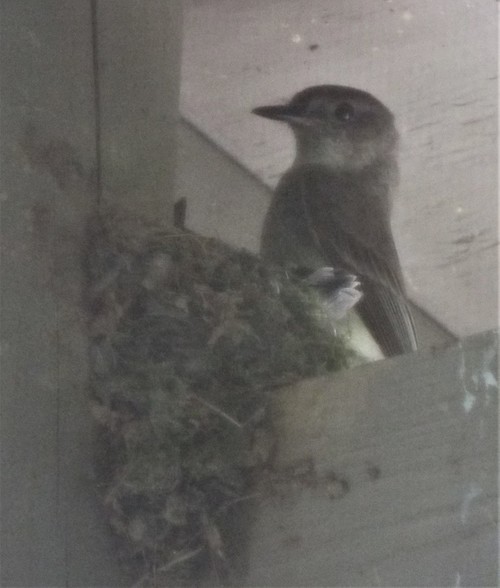
An earlier year. See the little beak on the left.
It’s amazing how quickly the babies grow. We read that the young typically remain in the nest about sixteen days after hatching, but within a few days the two were looking almost as large as the adults and their bodies were beginning to extend past the boundaries of the nest.
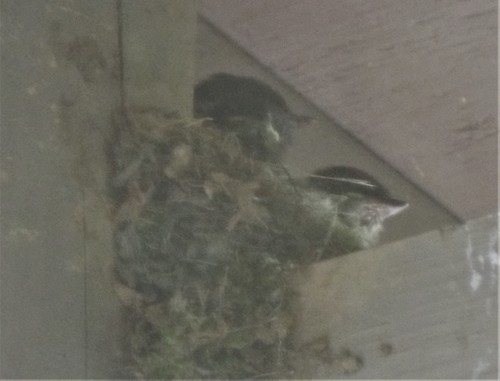
Two almost grown babies in an earlier year.
Then came the magical moment. I happened to be walking toward the door when I luckily saw a little one flutter—not fly, but flutter—from the nest to the porch rail. I had never seen a young bird make its first flight. It was almost as great as seeing one’s child or grandchild take those first baby steps. The young phoebe seemed as surprised as a child does when stepping out unassisted for the first time. It sat motionless on the rail for perhaps twenty minutes, glancing around as if wondering, “What do I do next?”
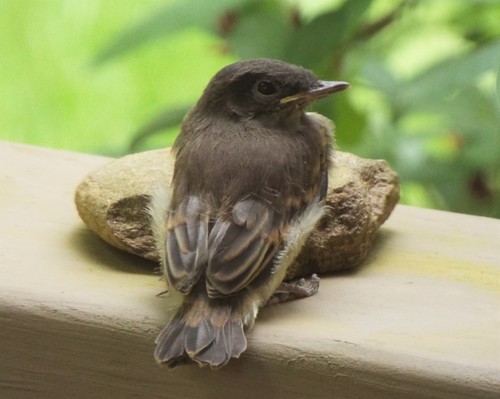
I’m out of the nest. Now what do I do?
When we passed by after those twenty minutes, the young phoebe was no longer on the rail, the nest was empty, and the new family was off somewhere with the adults apparently helping their young ones adapt to their new life out of the nest. We haven’t seen the babies since they left, but we did spot at least one of the adults. Hopefully they are taking a bit of a rest break before doing it all over again with a new brood, as is their custom each season. Wow! What a tough way to spend the summer.
As the phoebes have been finishing this round of their family life, there has been some activity on the deck on the other side of our house. For several years Carolina wrens have found a couple of cozy little spots for their own nesting activity. Their chosen locations are also under the protective roof in little pockets only about an inch and a half wide between two of the structural boards. A similar niche is located at each end of the deck roof and each has been used at one time or another over the years. Our first indication that something was happening this year was the discovery of twigs, grasses, and mosses scattered over the deck under the potential nest site. Someone had been clearing out the old nesting materials in preparation for something new. We soon spotted the male wren hanging around the deck, flying up to the nest area, and going down into it with bits of material. When not busy dealing with the nest, this tiny little fellow sits of the branches of the mountain ash tree adjacent to the deck. There he sings his lovely song for all he’s worth, apparently letting his mate or potential mate know that he’s working on a new home. And we do hear songs coming back from nearby as they “talk” about the possibilities. We read that the male wren starts the nest and then the female does the finishing work on the new home; seems like a good way to share in the process. One of the male’s chief activities now appears to be keeping unwanted visitors at a distance; we’ve already seen him very effectively chasing squirrels away from the deck in spite of their great difference in size. The wrens are still early in their building process, but we’re pleased to have another opportunity to share in their adventure as we watch through our living room door.
The wren was even singing for us just now as I was writing these words. What a joy to share this place here on the mountainside with such wonderful neighbors.
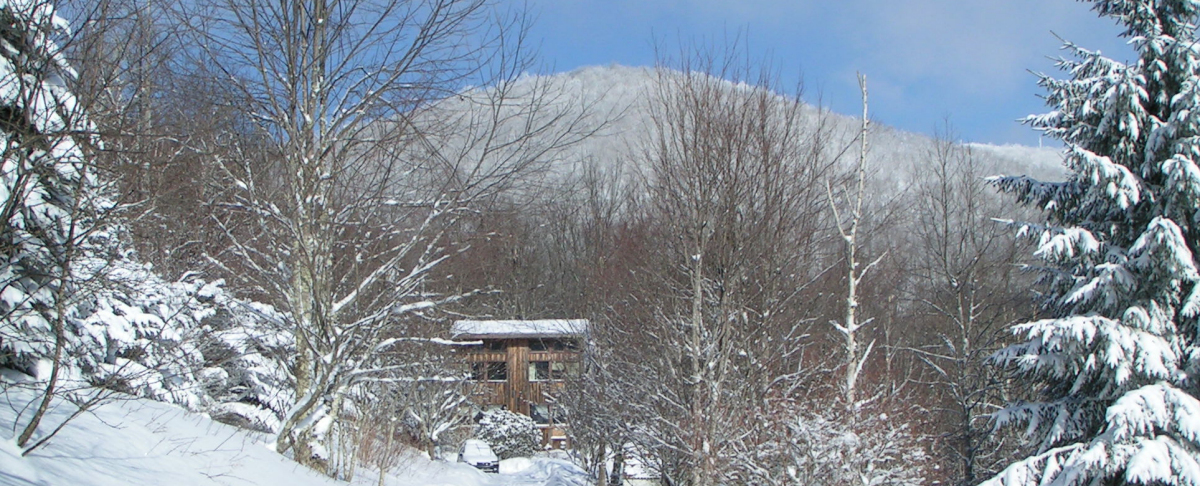
I thoroughly enjoyed reading this post! Yes, birds do make good neighbors!
Thanks, Leslie. They not only are good neighbors, but are also entertaining and fascinating to watch.
Pingback: Bursting with New Life: An Update from the Mountain – My Quiet Mountain Home